A conventional four door saloon and a five
door estate were offered, the latter (known as the Station Wagon) arguably
having the better styling. Inside, a digital dashboard was offered on some
models, as in the Tipo. The engine range consisted of the following : 1372cc
sohc (76bhp or, from 1992, 69bhp with injection and cat), 1581cc sohc (84bhp
or 77bhp with injection and catalytic converter) and 1756cc dohc (109bhp or, from 1992,
105bhp with injection and cat) petrol units and 1929cc sohc normally aspirated
(65bhp) and turbocharged (90bhp) diesel engines. Later in 1990 the 1995cc
injected and catalysed unit with 113bhp was also offered, as was
1991 saw the addition of a four-speed automatic
transmission to the 2.0ie, with switchable modes (normal or sport), whilst
from 1992 the 2.0ie Station Wagon was also available with a full-time four-wheel-drive
system, the latter also featuring ventilated discs at the front, solid discs at the rear and ABS.
The range was revised in 1993 when a new
grille was adopted, alongside improvements to the passive safety such as
side-impact bars, a strengthened floorpan and bulkhead and other improvements.
More changes came a year later when the model naming system was changed,
and a multi-point 1581cc sohc engine (with 90bhp) was introduced. Interior
trim and equipment was improved and a drivers airbag and ABS appeared on some models.
Production ceased in 1996 when it was replaced
by the Marea and Marea Station Wagon.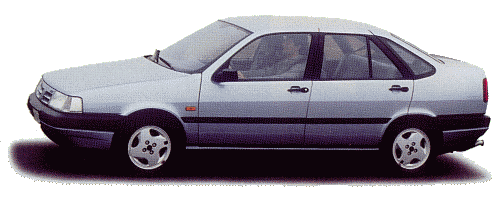 The
Tempra was introduced in February 1990 as a replacement for the Regata,
and was developed alongside the Alfa Romeo
155 and Lancia Dedra on the Tipo platform.
The
Tempra was introduced in February 1990 as a replacement for the Regata,
and was developed alongside the Alfa Romeo
155 and Lancia Dedra on the Tipo platform.
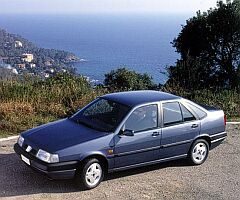 the 1929cc turbodiesel with EGR (80bhp).
the 1929cc turbodiesel with EGR (80bhp).
Technical Details
| Driveline | longitudinal engine at front with front wheel drive (or permanent four wheel drive) |
| Engine | 1371cc (80.5x67.4mm) sohc in-line 4-cyl with 76bhp @ 6,000rpm
1581cc (86.4x67.4mm) sohc in-line 4-cyl with 84bhp @ 5,800rpm (carburettor) 1581cc (86.4x67.4mm) sohc in-line 4-cyl with 90bhp @ 5,750rpm (injection) 1756cc (84x79.2mm) dohc in-line 4-cyl with 109bhp @ 6,000rpm (105bhp with cat) 1995cc (84x90mm) dohc in-line 4-cyl with 113bhp @ 5,750rpm 1929cc diesel sohc in-line 4-cyl with 65bhp @ 4,600rpm (turbocharged with 90bhp @ 4,100rpm) |
| Suspension | front : MacPherson strut with telescopic dampers and coil springs plus anti-roll bar
rear : Independent with trailing arms, telescopic dampers and coil springs plus anti-roll bar wheelbase : 2540mm track (front/rear) : 1435mm/1415mm |
| Brakes | front : discs (ventilated on some models)
rear : drums (discs on some models) handbrake operating on the rear via cable dual hydraulic circuit with servo assistance ABS optional/standard on some models |
| Gearbox | 5 speed manual
4 speed automatic optional on 2.0ie CVT optional |
| Steering | Rack and pinion with power assistance optional/standard on some models |
| Empty weight | 1.4 : 1070kg; 1.6 : 1075kg
1.8ie cat : 1690kg; 2.0ie SW 4x4 : 1880kg |
Here there are diagrams illustrating the structure of the Tempra saloon and Tempra Station Wagon.
Tuning
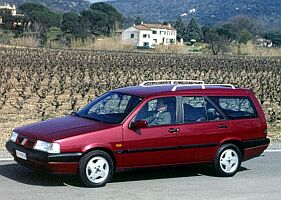 Almost
all the parts of the Tempra are from the FIAT/Alfa/Lancia parts bin, and
as such there is a multitude of options available.
Almost
all the parts of the Tempra are from the FIAT/Alfa/Lancia parts bin, and
as such there is a multitude of options available.
There are three main areas to concentrate on, the engine (and transmission), the brakes and the suspension and then various other details. These three should be done together since they complement each other, not all of one and none of another !
1. The engine.
Before modifying the engine it is worthwhile filling it with a good quality synthetic oil and fitting new spark plugs. An engine oil additive may also be used.
The first improvements are relatively simple.
The air filter can be replaced for an aftermarket item which will help
the engine breathe more freely, the types which completely replace the
airbox are best, and the exhaust can be replaced for one which will restrict
the exit of the gases less. Replace the whole system, not just the back box.
For single cam engines:
For fuel injected engines:
Other things to do should include fitting
a cold air intake, a large diameter pipe (minimum 5cm) to provide air from
outside the engine bay to the air filter. The exhaust manifold can also
be lagged with thermal cloth or tape to keep the exhaust gases hotter (and
thus reduce back pressure) and also to keep the underbonnet (and hence
intake and fuel) temperatures lower.
Further modifications require the machining
of the cylinder headand/or cylinder block (which will not be dealt with
here since it is not normally a DIY job) after which it may be worth fitting
an oil cooler. If overheating is a problem due to the increased power output
then a small hole can also be drilled through the plate in the thermostat.
Improving the fuelling is the biggest
change without opening the engine. A pair of downdraught or sidedraught
carburettors(about 40 in size) will provide adequate air-fuel mixture and
should also improve the throttle response. An improved camshaft will also
reap big benefits,especially when combined with the carburettors.
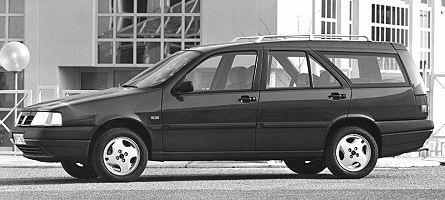 For twin cam carburettored engines:
For twin cam carburettored engines:
Again the approach of using a pair of
twin carburettors and a camshaft is the best way to wring more power from
these engines, after which work should centre on machining the cylinder head.
The most effective modification (short
of engine rebuilds!) is probably to replace the electronic control unit
(or 'chip'). A variety of these are available, but all should increase
the power and improve the driveability. For Tempra's the number of 'off-the-shelf'
units is limited, but it is possible to buy a unit which can be programmed
to any car and this will fulfill the role nicely.
The high tension leads can also be replaced with performance ones.
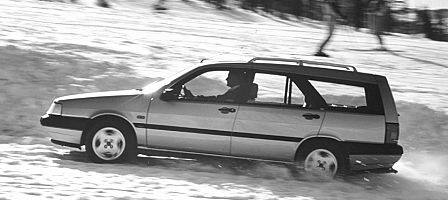 Regarding the transmission the main requirement
is to uprate the clutch to handle the increase in power and torque achieved
though the engine modifications. Friction plates can be purchased with
improved materials and heavier duty pressure plates are also available.
Whilst doing this it is worthwhile lightening the flywheel.
Regarding the transmission the main requirement
is to uprate the clutch to handle the increase in power and torque achieved
though the engine modifications. Friction plates can be purchased with
improved materials and heavier duty pressure plates are also available.
Whilst doing this it is worthwhile lightening the flywheel.
2. The brakes.
Initially it is relatively easy to replace
the brake discs with drilled and grooved items, and the pads for a harder
compound. The latter should not be too hard (ie no race pads on the road)
or they will not function effectively at the normal 'road' operating temperatures.
Stainless steel braided flexible hoses will improve the pedal feel and
reduce the chance of damage whilst DoT5 fluid (not silicon) will increase
the temperature at which it can operate effectively. If the brakes are
getting too hot the dustguards can be removed and/or ducts fitted, taking
air from behind the front bumper.
If more serious braking is required the
next modification would be to increase the disc size. It is possible to
use larger discs with a bracket allowing use of the production callipers,
or alloy four pot callipers can be fitted.
In order to improve the balance of the
car under braking it is desireable to be able to adjust the balance of
braking from front to rear (and vice versa). This can be accomplished by
fitting a bias valve in the line to the rear brakes, usually in a position
so that it can be reached from the drivers seat.
3. The suspension.
The easiest improvement,and the one which
will probably bring the single most noticeable change, is to replace the
full set of dampers and springs. A variety of kits are available which
include four matched dampers and springs. Top adjustable units are compromised,
but are good for road and track day cars since it allows the suspension
to be adjusted between these two, rather different, requirements. Coil
over units add more adjustability and can be purchased outright, or can
be made from standard dampers by welding a threaded sleeve to the standard tube.
There are then two other main suspension
aims; to reduce the flexiblity in the suspension and to increase the stiffness
of the car, Into this category also fall the choice
of wheels and tyres. With an increase in power it can be necessary to fit
larger tyres (thus requiring larger wheels) but the temptation to fit the
biggest possible should be resisted. Consideration should be given to fitting
a wider tyre on the front (since they provide traction and steering) but
keeping the standard, or a wider but not as wide as the front, tyre at
the rear. This will improve the balance of the car.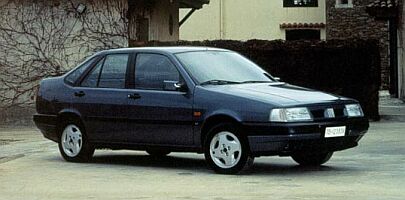 both
of which aim at more accurate control of the wheel movement. To reduce
the flexibility it is possible to fit nylon bushes instead of the normal
production rubber items, or if perfection is desired the suspension can
be fitted with metallic bearings (rose joints / rod ends). Spherical bearing
top mounts can also be used. To stiffen the car it is most popular to fit
strut braces. These can be fitted to the front and rear. For more extreme
cases a rollcage can be fitted.....
both
of which aim at more accurate control of the wheel movement. To reduce
the flexibility it is possible to fit nylon bushes instead of the normal
production rubber items, or if perfection is desired the suspension can
be fitted with metallic bearings (rose joints / rod ends). Spherical bearing
top mounts can also be used. To stiffen the car it is most popular to fit
strut braces. These can be fitted to the front and rear. For more extreme
cases a rollcage can be fitted.....
4. other things.
Other modifications worth considering include fitment of a shift light (and rev limiter if there is not one as standard), higher power bulbs in the headlights (if you are going to go faster you need to see further) and installation of a quicker steering rack.
Maintenance
These cars are generally robust and reliability
was never a major issue, although a few minor faults are more common.
The clutch slave cylinders have a tendency
to leak, the climate control system can give problems and the electrics
regarding the electronic dashboard and TDC sensor are known to be weak
points.
Buying / Selling
Now available at very low prices, the Tempra offers a lot of car for the price. The Station Wagon is especially good value - the design is more pleasant, and it has a huge load carrying capacity. The 2000 engined versions also offer a good turn of speed.
Some tips to do before selling : (they may seem obvious, but most people don't do them and thus are in a weaker bargaining position)
Tidy inside the car thoroughly : hoover
the floor, empty all pockets, ashtrays (wash), glove compartment etc...,
wipe the trim with a 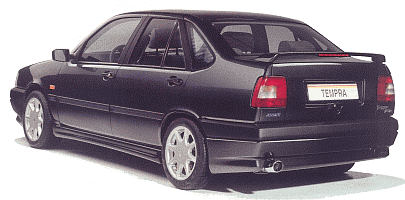 damp
cloth, give the cockpit a good airing to get rid of any odours ! Reset
the trip meter to 00000 - it is a pleasant (subconcious) surprise.
damp
cloth, give the cockpit a good airing to get rid of any odours ! Reset
the trip meter to 00000 - it is a pleasant (subconcious) surprise.
If the car has been standing give it a
good run - this will clear out the engine (reduce exhaust smoke), put a
shine on the brake discs and loosen up any joints that may otherwise make some noises.
'Back to black' products are very effective
at temporarily restoring bumpers and trim. This makes a big difference
to any car. Do it a week before you expect people to view the car, otherwise
it may be a bit too obvious !
Jetwash under the car, especially under
the engine and in the wheelarches. The prospective buyer may be an enthusiast,
and this makes it easier for them to see what they want to check.
Obviously wash the car and clean the windows !
If you are going to buy a car always check the following :
The bodywork should not be a major issue,
but check around just in case. The wheelarches, suspension and engine mounts,
sills, door pillars, scuttle panel and the floor can be easily inspected.
If a sunroof is fitted check around the edge. Check that there are no mismatching
panels, large areas of discolouration or signs of fresh paint. Compare
the paint colour in the engine bay with that of the exterior.
Check the main electrical functions - wipers,
windows, lights etc... try putting the main beam and wipers on at the same
time. Check the headlights for cracks.
Check the brake pedal does not go to the
floor if pressed hard for a long time and check the gearchange for clean engagement.
The engine should be run up to temperature,
check the exhaust for smoke (especially on the turbo models), the condition
of the breather (look for mayonnaise), the condition of the oil filler cap
(again white deposits can indicate a head gasket problem...) and the colour
of the coolant (preferably not brown!). If the car has an oil pressure
guage this should not drop below 1 bar at idle, and should be around 3
to 4 bar at speed. Listen to the noise of the engine, then depress the
clutch and engage first gear. Whatever noise has disappeared was coming
form the gearbox, what remains is from the engine. Check the condition
of the engine oil using the dipstick. It should be a lovely golden
-brown, darker is also ok but avoid the black stuff (except in dieels where this is the norm).
Check tyre wear, uneven patterns could imply a bent chassis.
Always take it for a test drive. Check
that the car tracks in a straight line with no steering input. Find a large
open area and complete several lock to lock turns (also in reverse), listening
for any noises. Try the handbrake when moving - seized rear callipers will
mean uneven braking or no braking.
Links
A Brazilian Tempra website (in Portuguese)
Fiat Tempra Workshop Manual :
buy it online here (in association with Amazon)
| Fiat Tipo & Tempra : Repair Manual & Service Guide | Porter, 1998 |
For more books on Fiats, see our Online Bookstore
Tempra comment form
Your Comments
The Fiat Tempra it´s
a great car. Here in Brazil we have the Tempra Stile Turbo, by Fiat. Simple
the best. 220km/h, 165HP, 2.0, ABS, and the best performance in the South
America, on the series cars. The Marea Turbo, by Fiat too, go to 227km/h,
with 182HP. So, Tempra has the force. :)
I own a 1990 Fiat Tempra 1.4 and despite the niggly problems, I like it. I adore the exterior shape
and the imposing dashboard design, housing the analogue dials (although
there's a clock where the rev counter should be!). The best thing about
the Tempra is that it isn't a like Cavalier or Sierra- it's a car for the
slighly different at heart!
I picked up my 1992 Tempra
for an absolute bargain price. These cars are so underrated - nobody seems
to like big Fiats - but it's the best car I ever owned.
It's March 2001, I'm thinking
of changing my Tempra 1.9TDSX Station Wagon (1994) for a more modern car
(Ford Mondeo/Volvo V40 Estate) but the more I look the more I think my
Tempra looks much nicer than any other estate on the road. It has it's
faults but out on the road it's the coolest looking motor. I've had it
5 yrs and it takes me mountaining biking around the UK, my wife scuba diving
and the family (2x kids) touring france every year - quality car and I've decided not to sell it. (Johnny H, UK)
My parents own a '95 Tempra Estate 1.8 SLX. It looks exactly the same as the red one you can see on the picture above. I fell in love with it when
I saw the car standing in the showroom and now, when I finally got my driving licene, I love it even more. This car is so underrated
that it seems like I 'm the only one driving it on our roads, and because you couldn't get the SLX version in Belgium (import from Italy) I 'm
likely to be one of the very few people in Belgium who can sit behind the wheel of this unique piece of Italian craftsmanship. Solid performance,
nice looking interior and gorgeous Latino styling make it a great car! You have to admit that it looks way better than any other estate on the road.
I just hope my parents won't sell it. (Filip S, Belgium).
Tempra 1.6SW 1995 model : This car is economical,reliable and spacious,with decent performance but ithink the interior trim is flimsy and exterior panels are susceptible to dings and dents.
overall though it is an underrated car that makes Astras and Escorts look poor. (Jaffa, UK)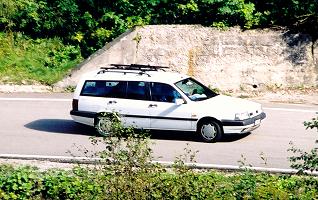 The only thing I can tell you about Fiat Tempra is this is one heck of a good car ;) We bought this
TD Station Wagon for a reasonable sum of money but hey, this is baby is
like a dream come true. Reliable, quiet, fantastic shape - you just don't
want to get out the seat. I just wonder how did we manage our lives without it...
The only thing I can tell you about Fiat Tempra is this is one heck of a good car ;) We bought this
TD Station Wagon for a reasonable sum of money but hey, this is baby is
like a dream come true. Reliable, quiet, fantastic shape - you just don't
want to get out the seat. I just wonder how did we manage our lives without it...
I've had my Tempra SW 2.0 SX for about 18 months. At first I thought it looked unremarkable and was very suspicious of the Space
Invaders wacky digital dash. But that didn't matter much to me as all I wanted was an estate at a good price. But it's really grown on me.
It has niggling faults like rattly exhaust, clattering rear calipers, a fuse box prone to drop on your foot at embarrasing moments, electrics
that do their own thing (when water leaks onto the fuse box) etc etc. This all adds up to a car with character that's really grown on me.
The engine is sweet and goes like train. 120mph no problem. I'm pleased with it and I've come realise how rare this model is in the UK -
so rare I end up waving at other Tempra SWs when I get to see them! (John, UK)
I had never thought much about Fiats in general, but that all changed when I bought my first own Fiat Tipo.
It had it's notorious electrical problems but boy, was it grate to drive! Now I have a Tempra 1.6, model 1995 sedan and I like it even better! It has a feeling
of a big car, it's terrific on the highway and on high speeds and ok in the city.The capacity of the trunk is worth noting also, it can take 2 childrens wagons
side by side and as a family man that pleases me. I've owned it for over a year now, and I haven't had any problems with it. I think i've lost my soul to
Fiats! I have already set my sights on the Marea, or perhaps the new astonishingly good looking Stilo. Thanks Italy for my car! (Jerry, Finland)
I have Tempra 1.6 S '94. Here in Poland those Fiats are not very popular. If you see it on the street you have 75% chances that it is a Taxi or Government vehicle.
As a matter of fact I've bought mine at low price becouse it was imported for the government.But it is a great car. It is relatively cheap and rare. That matters becouse
I don't have to worry that it will be stolen. And its big, so people give more respect.Oh, and becouse Tempras are considered to be cars of the gov. and mine looks just
like one of them, I sometimes use that image when parking in the strict centre or speeding on the fast lane.Never have I been fined or stopped.But you can do it only when your
body paint is Green Stone(2nd pic from the top). I've put inside quite good audio system(cd+amp+bass) and also I've instaled electric windows from Tipo and an
refridgerator in the trunk (all on my own). It became a luxurious ;-) (Peter,Poland)
There is also a list of all our picture galleries (including museums, motorshows and various events).
Wallpapers/Desktop Backgrounds of numerous Fiats also available to download.
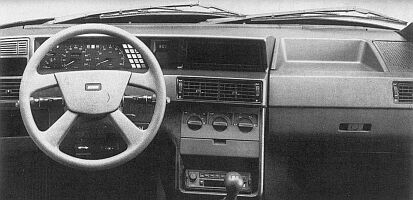
Use the buttons at the top to navigate further, or
Copyright © 2000 to 2008 CarsfromItaly